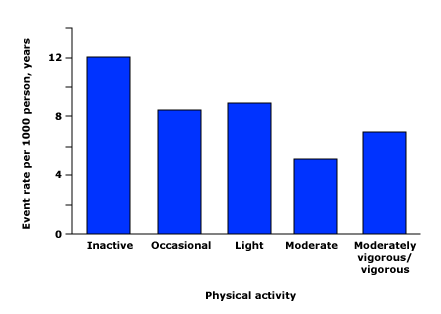In the United States and most developed countries, CardioVascular Disease (CVD), which includes coronary Artery Disease (CAD), stroke, and peripheral arterial disease, is far and away the leading cause of death.
Individuals who consume a healthy diet have significantly lower risks of Cardiovascular Disease, including both CAD and stroke. Components of a healthy diet include:
- High intakes of fruits and vegetables
- High fiber intake, including cereals
- Low sugar load
- Monounsaturated fat rather than trans fatty acids or saturated fats
- Limited intake of red or processed meats
- Omega-3 fatty acids (from fish, fish oil supplements, or plant sources)
Studies have consistently shown that individuals consuming diets high in vegetables and fruits have a reduced risk of CAD. Better lifestyle habits can help you reduce your risk for heart attack. Learn what you can do to help prevent heart disease and stroke.
You Are What You Eat
Better food habits can help you reduce your risk for heart attack. A healthful eating plan means choosing the right foods to eat and preparing foods in a healthy way.
Exercise and Fitness
Regular physical activity is recommended in the early school years and throughout life: Life-long appropriate physical activity consists of 30 to 60 minutes of exercise, four to six times a week.
Coronary Artery Disease events
(From Wannamethee, SG, Shaper, AG, Alberti, KG, Arch Intern Med 2000; 160:2108)
Coronary events are less frequent among those who exercise. In a study of 5159 men, aged 40 to 49 years, followed for an average of almost 19 years, the age-adjusted coronary artery disease event rate per 1000 person-years is lower in those who perform any physical activity compared to inactive subjects.
Physical inactivity is a major risk factor for cardiovascular disease, and most Americans are not physically active enough to gain any health benefits. Swimming, cycling, jogging, skiing, aerobic dancing, walking or many other activities can help your heart. Whether it’s included in a structured exercise program or part of your daily routine, all physical activity adds up to a healthier heart.
How Do You Maintain Weight Loss?
Obesity increases several risk factors for CVD, including hypertension, dyslipidemia, and insulin resistance as well as diabetes. Data from a number of large studies have consistently shown a direct relationship of higher body weight with CAD.
Once you’ve lost weight, the next step is to keep it off. Learn what to expect and get tips for success.
Childhood Obesity
The American Heart Association and the Clinton Foundation are working together to raise public awareness about the serious threat posed by childhood obesity. Learn more about this alliance and how you can become involved in improving children’s health.
Physical Activity and Exercise
An increase in physical activity is an important part of your weight management program. Most weight loss occurs because of decreased caloric intake. Sustained physical activity is most helpful in the prevention of weight regain. In addition, exercise has a benefit of reducing risks of cardiovascular disease and diabetes, beyond that produced by weight reduction alone. Start exercising slowly and gradually increase the intensity. Trying too hard at first can lead to injury.
Your exercise can be done all at one time, or intermittently over the day. Initial activities may be walking or swimming at a slow pace. You can start out by walking 30 minutes for three days a week and can build to 45 minutes of more intense walking, at least five days a week. With this regimen, you can burn 100 to 200 calories more per day. All adults should set a long-term goal to accumulate at least 30 minutes or more of moderate-intensity physical activity on most, and preferably all, days of the week. This regimen can be adapted to other forms of physical activity, but walking is particularly attractive because of its safety and accessibility. Also, try to increase “every day” activity such as taking the stairs instead of the elevator. Reducing sedentary time is a good strategy to increase activity by undertaking frequent, less strenuous activities. With time, you may be able to engage in more strenuous activities. Competitive sports, such as tennis and volleyball, can provide an enjoyable form of exercise for many, but care must be taken to avoid injury.
|
Examples of moderate amounts of physical activity |
|
|
Sporting Activities |
Common Chores |
|
Playing volleyball for 45-60 minutes |
Washing and waxing a car for 45-60 minutes |
|
Playing touch football for 45 minutes |
Washing windows or floors for 45-60 minutes |
|
Walking 1.75 miles in 35 minute (20min/mile) |
Gardening for 30-45 minutes |
|
Basketball (shooting baskets) 30 minutes |
Wheeling self in wheelchair 30-40 minutes |
|
Bicycling 5 miles in 30 minutes |
Pushing a stroller 1.5 miles in 30 minutes |
|
Dancing fast (social) for 30 minutes |
Raking leaves for 30 minutes |
|
Water aerobics for 30 minutes |
Walking 2 miles in 30 minutes (15 min/mile) |
|
Swimming Laps for 20 minutes |
Shoveling snow for 15 minutes |
|
Basketball (playing game) for 15-20 minutes |
Stairwalking for 15 minutes |
|
Jumping rope for 15 minutes |
|
|
Bicycling 4 miles in 15 minutes |
|
|
Running 1.5 miles in 15 min. (10min/mile) |
|
For the beginner, activity level can begin at very light and would include an increase in standing activities, special chores like room painting, pushing a wheelchair, yard work, ironing, cooking, and playing a musical instrument.
The next level would be light activity such as slow walking of 24 min/mile, garage work, carpentry, house cleaning, child care, golf, sailing, and recreational table tennis.
The next level would be moderate activity such as walking 15 minute/mile, weeding and hoeing a garden, carrying a load, cycling, skiing, tennis, and dancing.
High activity would include walking 10 minute/mile or walking with load uphill, tree felling, heavy manual digging, basketball, climbing, or soccer/kick ball.
You may also want to try:
- flexibility exercise to attain full range of joint motion
- strength or resistance exercise
- aerobic conditioning


